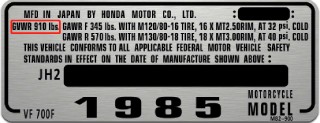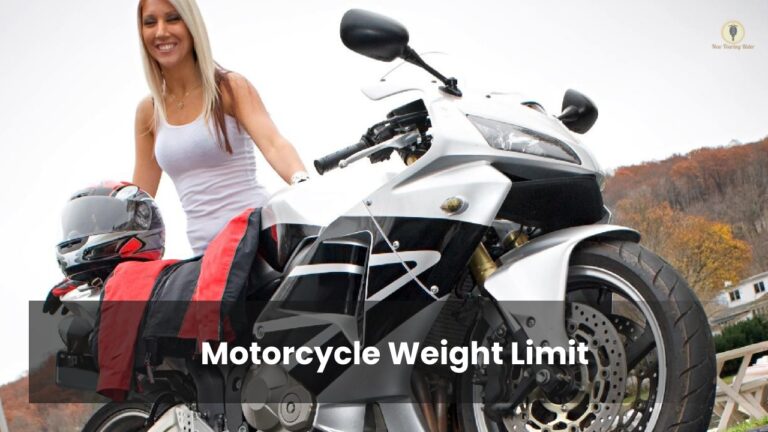Most motorcycles have a weight limit from 350lbs to 450lbs or more or less, depending on model type. Use this simple math to calculate your motorcycle’s weight limit capacity:
Motorcycle Weight Limit = GVWR – Wet Weight
Your motorcycle’s manufacturer provides a gross vehicle weight rating (GVWR) for each model. Take the GVWR, subtract the weight of your bike. This will show you how much more weight you can safely carry, includes rider, passenger, trailer, and luggage.
1. Where do I find the GVWR?
The GVWR stands for Gross Vehicle Weight Rating, which means the manufacturer’s recommended safe maximum total weight of a motorcycle and its contents, including passengers, fuel, cargo, etc.
You can find your GVWR number in several places;
- Located on the vehicle-identification-number (VIN) plate, usually stamped into the steering neck or nearby frame.
- Owner’s Manual
- Service Manual / Repair Manual
- The manufacturer’s website

Note: some Harley Davidson also has a Gross Axle Weight(GAW), which is not the same as GVWR. Other European bikes might use metric weights in kilograms (Kg). One Kilogram is around 2.2 pounds, so you should be able to convert this to pounds in your head.
2. Determine Motorcycle’s Dry and Wet Weight
Dry weight is the motorcycle’s weight with no fluids or fuel, either by looking up your owner’s manual or repair manual.
Wet Weight (also called curb weight) is the bike weighs with fluids, add typically 40 to 50 lbs. to dry weight.
3. The Motorcycle Maximum Cargo Weight
Take the two numbers from above, GVWR – Wet Weight = Motorcycle Weight Limit
Next, subtract your weight and all your riding gear; such as helmet, boots, and jacket. This is the Maximum Cargo Weight you can safely add.
Motorcycle Weight Limit Chart
| Brands | Curb Weight (lbs.) | GVWR | Max Weight Capacity* |
| Honda GL1000 Gold Wing | 584 | 944 | 360 |
| Honda GL1100 Gold Wing | 764 | 1105 | 341 |
| Honda GL1200 Gold Wing | 780 | 1170 | 390 |
| Honda GL1500I Gold Wing Interstate | 848 | 1257 | 408 |
| Honda GL1800 Gold Wing | 833 | 1256 | 423 |
| Honda Click 125i | 234 | 503 | 269 |
| Honda shadow 750 | 553 | 954 | 401 |
| Harley Davidson FLH series | 880 | 1360 | 480 |
| Harley-Davidson FLHT | 810 | 1259 | 449 |
| Harley-Davidson Sportster Iron 883 | 564 | 950 | 386 |
| 2016 Kawasaki Concurs, with bags | 690 | 1193 | 503 |
| 2016 BMW 1200 RT | 603 | 1089 | 486 |
| Suzuki DL650 V-Storm | 520 | 926 | 406 |
| Suzuki DL1000 V-Storm | 590 | 965 | 375 |
| Yamaha YZF-R6 (2010-2016) | 417 | 827 | 410 |
| Yamaha Royal Star Venture Tour Delux | 842 | 1241 | 399 |
| Yamaha v-star 650 | 514 | 911 | 397 |
Maintenance & Adjustments Which Affect Your Weight Limit
1. Tires
Tread depth, road damage, uneven wear, and sidewall cracking is the first thing to look for when checking tires before a long trip. If the tread has worn away to less than the depth indicated by an update in your owner’s manual, you should replace them.
It is important to check tire pressure and make sure all tires are inflated properly before every trip. Under heavier loads, higher inflation psi can increase your tire life and improve handling on the road.
Read more about tires, post – Should I Replace Both Tires at the Same Time?
2. Suspension Forks and Rear Shocks
When you tour with full loads, it is best to preload the forks and rear shocks to stiffen the spring. You can do this by mechanical adjustment or by adding air.
3. Chains & Sprockets
Chains and sprockets are the key components of a bike. It’s important to keep them well lubricated and adjusted for their life expectancy to be longer.
4. Engine & Oil
You need to do basic maintenance on your bike. For example, valve adjustments, service spark plugs, change filters and coolant. When you are riding with a heavy load, Please follow the recommended fluids and oil schedule according to the severe or extreme conditions.
Tips for Loading
- Keep the heaviest items go at the bottom of saddlebags or backpacks
- If you’re loading up your saddlebags, make sure each one is loaded with about the same weight. The motorcycle might drift in one direction if you’re not careful about where your weight is distributed.
- Pack food that is made for hikers and go to the grocery store often. You can also go to restaurants, but they will be expensive.
- Don’t use heavy add-on rear “top cases”.
- You want to avoid adding anything that will add weight to the front end of your motorcycle because it will make the steering unmanageable.
- Make sure everything is strapped in. Secure your load with strong, elastic ropes before hitting the road. You don’t want it to catch on a wheel or chain and cause you any problems!
- It’s important to make sure the load is safe and secure. Not only should you stop periodically, but also check that it hasn’t worked loose or shifted around too much in transit.
Tips for Handling a Heavy Loaded Motorcycle
1. Do several simulated panic stops: to find out your stopping distance with the load before the tour.
2. Keep safe stopping distance: heavier vehicles can result in longer stopping distances and time.
3. Be prepared to stop and prop – a firm footing is essential – watch out for graded gravel if you are forced to pull over on the roadside
4. Cold Weather – Start by slowing down so that those cold rubber can warm up over time while on the road; this will help prevent any premature wear or damage from happening before they get a chance to heat back up again.
5. Parking – Choose an area with enough room and a flat, smooth surface so that when you park your motorcycle, there’s no leaning involved or any chance of slipping.
Carrying Passenger
If you’re carrying someone, it’s your job not just to keep them safe but also to ensure that they know what safety precautions need to take place before and during the ride.
Please let your passenger know:
- Get on the motorcycle only after you have been ready. Make sure you’re braced well with your feet planted firmly on either side, keeping the front wheel straight, the motorcycle is vertical.
- Ask them to sit as far forward on the motorcycle as possible without crowding you.
- Holding firmly to your waist, hips, or belt.
- Keep their legs away from your muffler.
- When cornering, the passenger should lean as you lean and look over your inside shoulder.
- Ask your passenger to watch carefully and be ready for braking. It’s important that you are smooth when accelerating or slowing down, but the passengers play a huge role in bike stability!
- When riding a motorcycle, avoid unnecessary talking and motion. Verbal interaction can be nearly impossible at speed. Hand signals are okay, but if you regularly ride with a passenger, consider Bluetooth communicators for the convenience it brings to two-up rides.
About Bike Trailers
Motorcycle trailers are not for the novice motorcyclist. They will have a difficult time handling their bike and trailer when something goes wrong on the road, making it more dangerous than just driving without one!
Wrapping Up
A motorcycle is an exciting way to travel and explore your surroundings but with great power comes responsibility. Your bike has limitations on how much weight it can carry safely. It’s important that you know the weight limit of your motorcycle before loading it up with anything too heavy.



Motorcycle GVWR figures are well nigh impossible to find online.